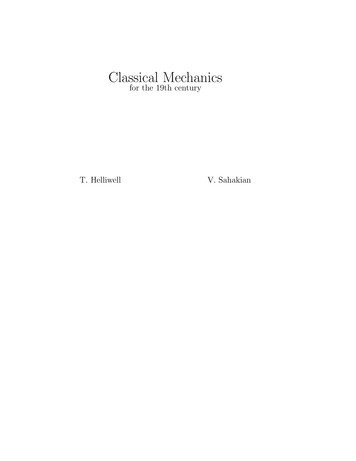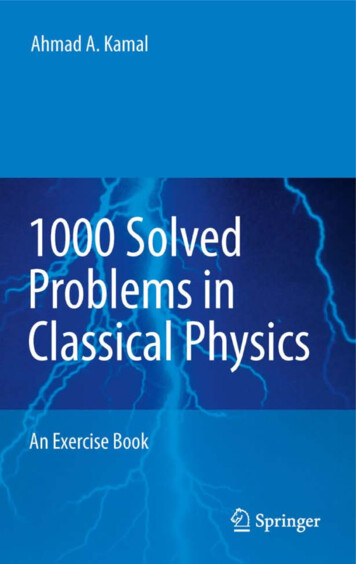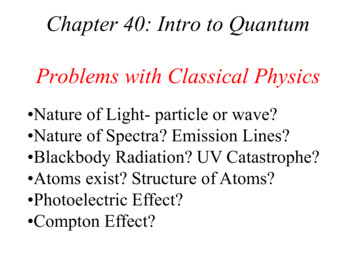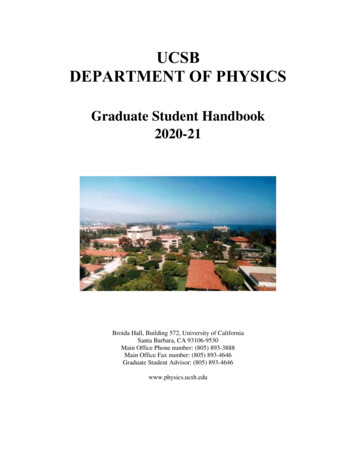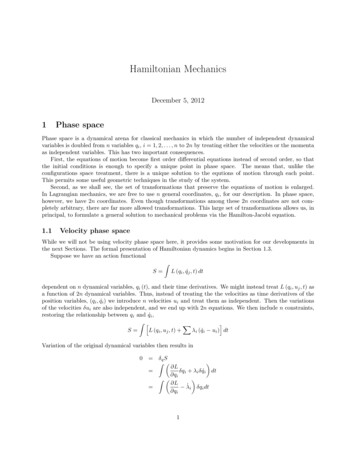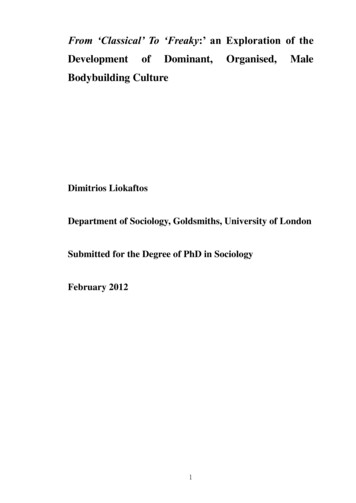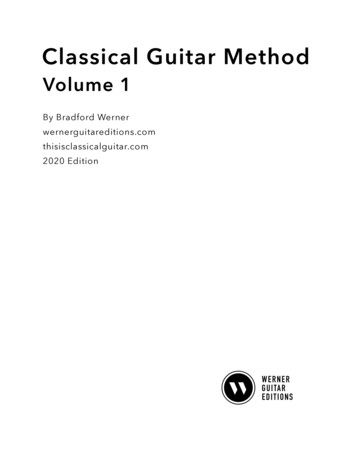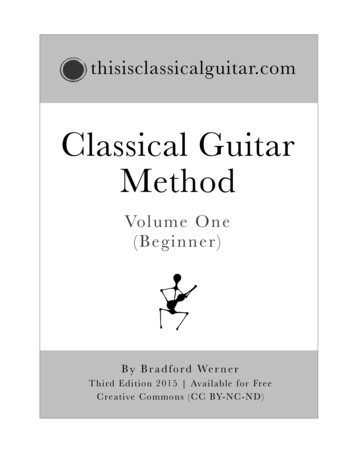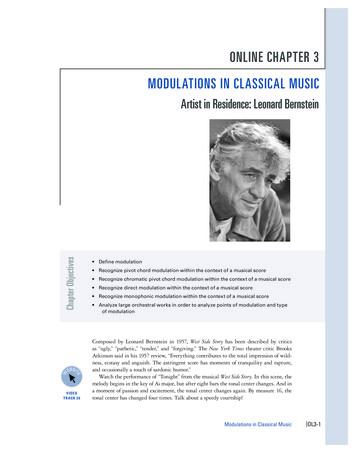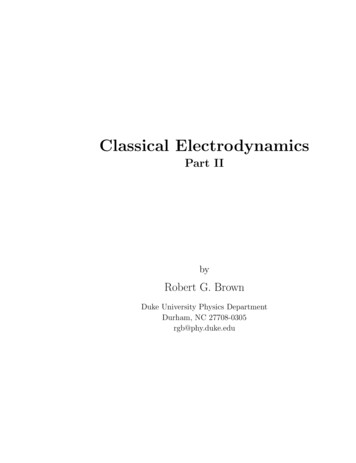
Transcription
Classical ElectrodynamicsPart IIbyRobert G. BrownDuke University Physics DepartmentDurham, NC 27708-0305rgb@phy.duke.edu
AcknowledgementsI’d like to dedicate these notes to the memory of Larry C. Biedenharn.Larry was my Ph.D. advisor at Duke and he generously loaned me his(mostly handwritten or crudely typed) lecture notes when in the naturalcourse of events I came to teach Electrodynamics for the first time. Mostof the notes have been completely rewritten, typeset with latex, changedto emphasize the things that I think are important, but there are still important fragments that are more or less pure Biedenharn, in particular thelovely exposition of vector spherical harmonics and Hansen solutions (whicha student will very likely be unable to find anywhere else).I’d also like to acknowledge and thank my many colleagues at Duke andelsewhere who have contributed ideas, criticisms, or encouragement to meover the years, in particular Mikael Ciftan (my “other advisor” for my Ph.D.and beyond), Richard Palmer and Ronen Plesser.Copyright NoticeCopyright Robert G. Brown 1993, 2007
NoticeThis set of “lecture notes” is designed to support my personal teaching activities at Duke University, in particular teaching its Physics 318/319series (graduate level Classical Electrodynamics) using J. D. Jackson’s Classical Electrodynamics as a primary text. However, the notes may be usefulto students studying from other texts or even as a standalone text in its ownright.It is freely available in its entirety online athttp://www.phy.duke.edu/ rgb/Class/phy319.phpas well as through Lulu’s “book previewer” athttp://www.lulu.com/content/1144184(where one can also purchase an inexpensive clean download of the bookPDF in Crown Quarto size – 7.444 9.681 inch pages – that can be readusing any PDF browser or locally printed).In this way the text can be used by students all over the world, whereeach student can pay (or not) according to their means. Nevertheless, I amhoping that students who truly find this work useful will purchase eitherthe PDF download or the current paper snapshot, if only to help subsidizeme while I continue to write more inexpensive textbooks in physics or othersubjects.These are real lecture notes, and they therefore have errors great andsmall, missing figures (that I usually draw from memory in class), and theycover and omit topics according to my own view of what is or isn’t importantto cover in a one-semester course. Expect them to change without warningas I add content or correct errors. Purchasers of a paper version shouldbe aware of its imperfection and be prepared to either live with it or markup their own copies with corrections or additions as need be in the lecturenote spirit, as I do mine. The text has generous margins, is widely spaced,and contains scattered blank pages for students’ or instructors’ own use tofacilitate this.I cherish good-hearted communication from students or other instructorspointing out errors or suggesting new content (and have in the past donemy best to implement many such corrections or suggestions).
ContentsPrefaceiii1 Syllabus and Course RulesI31.1Contact Information . . . . . . . . . . . . . . . . . . . . . .31.2Useful Texts and Web References . . . . . . . . . . . . . . .31.3Course Description . . . . . . . . . . . . . . . . . . . . . . .51.4Basis of Grade . . . . . . . . . . . . . . . . . . . . . . . . . .61.4.1Percentages . . . . . . . . . . . . . . . . . . . . . . .61.4.2Research Project: . . . . . . . . . . . . . . . . . . . .71.5Course Rules . . . . . . . . . . . . . . . . . . . . . . . . . .81.6The Interplay of Physics andMathematics . . . . . . . . . .10Mathematical Physics132 Mathematical Prelude153 Vector Calculus: Integration by Parts194 Numbers234.1Real Numbers . . . . . . . . . . . . . . . . . . . . . . . . . .234.2Complex Numbers . . . . . . . . . . . . . . . . . . . . . . .254.3Contour Integration . . . . . . . . . . . . . . . . . . . . . . .29i
4.4Geometric Algebra . . . . . . . . . . . . . . . . . . . . . . .5 Partial Differential Equations29315.1The Laplace Equation . . . . . . . . . . . . . . . . . . . . .315.2The Helmholtz Equation . . . . . . . . . . . . . . . . . . . .315.3The Wave Equation . . . . . . . . . . . . . . . . . . . . . . .316 Tensors336.1The Dyad and N -adic Forms . . . . . . . . . . . . . . . . . .336.2Coordinate Transformations . . . . . . . . . . . . . . . . . .377 Group Theory437.1Definition of a Group . . . . . . . . . . . . . . . . . . . . . .437.2Groups of Transformation . . . . . . . . . . . . . . . . . . .438 Math References45II49Non-Relativistic Electrodynamics9 Plane Waves9.19.29.351The Free Space Wave Equation . . . . . . . . . . . . . . . .519.1.1Maxwell’s Equations . . . . . . . . . . . . . . . . . .519.1.2The Wave Equation . . . . . . . . . . . . . . . . . . .529.1.3Plane Waves . . . . . . . . . . . . . . . . . . . . . . .549.1.4Polarization of Plane Waves . . . . . . . . . . . . . .57Reflection and Refraction at a Plane Interface . . . . . . . .609.2.1Kinematics and Snell’s Law . . . . . . . . . . . . . .619.2.2Dynamics and Reflection/Refraction . . . . . . . . .61Dispersion . . . . . . . . . . . . . . . . . . . . . . . . . . . .689.3.169Static Case . . . . . . . . . . . . . . . . . . . . . . .
9.3.2Dynamic Case . . . . . . . . . . . . . . . . . . . . . .709.3.3Things to Note . . . . . . . . . . . . . . . . . . . . .729.3.4Anomalous Dispersion, and Resonant Absorption . .739.3.5Attenuation by a complex ǫ . . . . . . . . . . . . . .749.3.6Low Frequency Behavior . . . . . . . . . . . . . . . .769.3.7High Frequency Limit; Plasma Frequency . . . . . . .77Penetration of Waves Into a Conductor – Skin Depth . . . .799.4.1Wave Attenuation in Two Limits . . . . . . . . . . .799.5Kramers-Kronig Relations . . . . . . . . . . . . . . . . . . .819.6Plane Waves Assignment . . . . . . . . . . . . . . . . . . . .849.410 Wave Guides8710.1 Boundary Conditions at a Conducting Surface: Skin Depth .8710.2 Mutilated Maxwell’s Equations (MMEs) . . . . . . . . . . .9410.3 TEM Waves . . . . . . . . . . . . . . . . . . . . . . . . . . .9810.4 TE and TM Waves . . . . . . . . . . . . . . . . . . . . . . .9910.4.1 TM Waves . . . . . . . . . . . . . . . . . . . . . . . . 10110.4.2 Summary of TE/TM waves . . . . . . . . . . . . . . 10210.5 Rectangular Waveguides . . . . . . . . . . . . . . . . . . . . 10310.6 Resonant Cavities . . . . . . . . . . . . . . . . . . . . . . . . 10510.7 Wave Guides Assignment . . . . . . . . . . . . . . . . . . . . 10611 Radiation10711.1 Maxwell’s Equations, Yet Again . . . . . . . . . . . . . . . . 10711.1.1 Quickie Review of Chapter 6 . . . . . . . . . . . . . . 10811.2 Green’s Functions for the Wave Equation . . . . . . . . . . . 11011.2.1 Poisson Equation . . . . . . . . . . . . . . . . . . . . 11111.2.2 Green’s Function for the Helmholtz Equation . . . . 11211.2.3 Green’s Function for the Wave Equation . . . . . . . 115
11.3 Simple Radiating Systems . . . . . . . . . . . . . . . . . . . 11811.3.1 The Zones . . . . . . . . . . . . . . . . . . . . . . . . 11911.3.2 The Near Zone . . . . . . . . . . . . . . . . . . . . . 12011.3.3 The Far Zone . . . . . . . . . . . . . . . . . . . . . . 12211.4 The Homogeneous Helmholtz Equation . . . . . . . . . . . . 12311.4.1 Properties of Spherical Bessel Functions . . . . . . . 12411.4.2 JL (r), NL (r), and HL (r) . . . . . . . . . . . . . . . . 12611.4.3 General Solutions to the HHE . . . . . . . . . . . . . 12711.4.4 Green’s Functions and Free Spherical Waves . . . . . 12711.5 Electric Dipole Radiation . . . . . . . . . . . . . . . . . . . . 12911.5.1 Radiation outside the source . . . . . . . . . . . . . . 13011.5.2 Dipole Radiation . . . . . . . . . . . . . . . . . . . 13011.6 Magnetic Dipole and Electric Quadrupole Radiation Fields . 13511.6.1 Magnetic Dipole Radiation . . . . . . . . . . . . . . . 13611.6.2 Electric Quadrupole Radiation . . . . . . . . . . . . . 13711.7 Radiation Assignment . . . . . . . . . . . . . . . . . . . . . 14012 Vector Multipoles14512.1 Angular momentum and spherical harmonics . . . . . . . . . 14512.2 Magnetic and Electric Multipoles Revisited . . . . . . . . . . 14812.3 Vector Spherical Harmonics and Multipoles . . . . . . . . . . 15013 The Hansen Multipoles15913.1 The Hansen Multipoles . . . . . . . . . . . . . . . . . . . . . 16013.1.1 The Basic Solutions . . . . . . . . . . . . . . . . . . . 16013.1.2 Their Significant Properties . . . . . . . . . . . . . . 16013.1.3 Explicit Forms . . . . . . . . . . . . . . . . . . . . . 16113.2 Green’s Functions for the Vector Helmholtz Equation . . . . 16213.3 Multipolar Radiation, revisited . . . . . . . . . . . . . . . . 163
13.4 A Linear Center-Fed Half-Wave Antenna . . . . . . . . . . . 17013.5 Connection to Old (Approximate) Multipole Moments. . . 17413.6 Angular Momentum Flux . . . . . . . . . . . . . . . . . . . 17613.7 Concluding Remarks About Multipoles . . . . . . . . . . . . 18013.8 Table of Properties of Vector Harmonics . . . . . . . . . . . 18114 Optical Scattering18514.1 Radiation Reaction of a Polarizable Medium . . . . . . . . . 18514.2 Scattering from a Small Dielectric Sphere . . . . . . . . . . . 18814.3 Scattering from a Small Conducting Sphere. . . . . . . . . 19414.4 Many Scatterers . . . . . . . . . . . . . . . . . . . . . . . . . 197IIIRelativistic Electrodynamics15 Special Relativity20120315.1 Einstein’s Postulates . . . . . . . . . . . . . . . . . . . . . . 20315.2 The Elementary Lorentz Transformation . . . . . . . . . . . 20415.3 4-Vectors . . . . . . . . . . . . . . . . . . . . . . . . . . . . . 21015.4 Proper Time and Time Dilation . . . . . . . . . . . . . . . . 21515.5 Addition of Velocities . . . . . . . . . . . . . . . . . . . . . . 21615.6 Relativistic Energy and Momentum . . . . . . . . . . . . . . 21916 The Lorentz Group22516.1 The Geometry of Space–Time . . . . . . . . . . . . . . . . . 22516.2 Tensors in 4 Dimensions . . . . . . . . . . . . . . . . . . . . 22816.3 The Metric Tensor . . . . . . . . . . . . . . . . . . . . . . . 23116.4 Generators of the Lorentz Group . . . . . . . . . . . . . . . 23516.4.1 Infinitesimal Transformations . . . . . . . . . . . . . 23616.5 Thomas Precession . . . . . . . . . . . . . . . . . . . . . . . 246
16.6 Covariant Formulation of Electrodynamics . . . . . . . . . . 25316.7 The Transformation of Electromagnetic Fields . . . . . . . . 25917 Relativistic Dynamics26117.1 Covariant Field Theory . . . . . . . . . . . . . . . . . . . . . 26117.1.1 The Brute Force Way . . . . . . . . . . . . . . . . . . 26217.1.2 The Elegant Way . . . . . . . . . . . . . . . . . . . . 26617.2 Motion of a Point Charge in a Static Magnetic Field. . . . 27217.3 Building a Relativistic Field Theory . . . . . . . . . . . . . . 27317.4 The Symmetric Stress Tensor . . . . . . . . . . . . . . . . . 27717.5 Covariant Green’s Functions . . . . . . . . . . . . . . . . . . 28018 Radiation from Point Charges28718.1 Larmor’s Formula . . . . . . . . . . . . . . . . . . . . . . . . 29218.2 Thomson Scattering of Radiation . . . . . . . . . . . . . . . 29719 Radiation Reaction19.1 The Death of Classical Physics301. . . . . . . . . . . . . . . . 30119.2 Radiation Reaction and Energy Conservation . . . . . . . . 30419.3 Integrodifferential Equations of Motion . . . . . . . . . . . . 30819.4 Radiation Damping of an Oscillating Charge . . . . . . . . . 31119.5 Dirac’s Derivation of Radiation Reaction . . . . . . . . . . . 31419.6 Wheeler and Feynman’s Derivation of Radiation Reaction . . 31419.7 My Own Field-Free Derivation of Radiation Reaction . . . . 314
PrefaceClassical Electrodynamics is one of the most beautiful things in the world.Four simple vector equations (or one tensor equation and an asssociateddual) describe the unified electromagnetic field and more or less directlyimply the theory of relativity. The discovery and proof that light is anelectromagnetic wave stands to this day as one of the greatest moments inthe history of science.These four equations even contain within them the seeds of their owndestruction as a classical theory. Once Maxwell’s equations were known,the inconsistency of the classical physics one could then easily derive fromthem with countless experimental results associated with electromagnetismforced the classicists of the day, many of them metaphorically kicking orscreaming, to invent quantum mechanics and quantum electrodynamics toexplain them. Indeed, once the single fact that an accelerated charged particle necessarily radiates electromagnetic energy was known, it became virtually impossible to conceptually explain the persistence of structure at themicroscopic level (since the forces associated with binding objects togetherout of discrete charged parts inevitably produce an oscillation of charge dueto small perturbations of position, with an associated acceleration)., Thefew hypotheses that were advanced to account for it “without” an overtlyoscillatory model were rapidly and decisively shot down by (now famous)experiments by Rutherford, Millikan, and others.Even though the Universe proves to be quantum mechanical at the microscopic level, classical electrodynamics is nevertheless extremely relevantand useful in the real world today at the macroscopic level. It describesextremely precisely nearly all the mundane aspects of ordinary electrical engineering and electromagnetic radiation from the static limit through opticalfrequencies. Even at the molecular level or photonic level where it breaksvii
down and a quantum theory must be used it is first necessary to understandthe classical theory before exploring the quantum theory, as the quantumtheory is built on top of the entire relativistic electrodynamic conceptualframework already established.This set of lecture notes is designed to be used to teach graduate students(and possibly advanced and motivated undergraduates) classical electrodynamics. In particular, it supports the second (more difficult) semester of atwo semester course in electrodynamics that covers pretty much “all” of thetheory itself (omitting, of course, many topics or specific areas where it canbe applied) out to the points where the theory itself breaks down as notedabove. At that point, to make further progress a student needs to learnabout more fields, quantum (field) theory, advanced (general) relativity –topics generally beyond the scope of these notes.The requirements for this course include a thorough understanding ofelectricity and magnetism at the level of at least one, ideally two, undergraduate courses. At Duke, for example, physics majors are first exposed firstto an introductory course that covers the integral formulation of Maxwell’sequations and light that uses no multivariate differential calculus, then asecond course that develops the vector differential formulation of Maxwell’sequations and their consequences) as does this course) but with considerablyless mathematical rigor and completeness of the treatment as students taking it have likely still not had a course in e.g. contour integration. Studentsusing these notes will find it useful to be at least somewhat comfortablewith vector differential and integral calculus, to have had exposure to thetheory and solution methodology of ordinary and partial differential equations, to be familiar with the mathematics of complex variables and analyticfunctions, contour integration, and it would be simply lovely if they at leastknew what a “tensor” was.However, even more so than is the case for most physics texts, this bookwill endeavor to provide internal support for students that are weak in oneor more of these required mathematical skills. This support will come in oneof several forms. At the very least, considerable effort has been made to huntdown on behalf of the student and explicitly recommend useful textbooksand online resources on various mathematical and physical topics that maybe of use to them. Many of these resources are freely available on the web.Some mathematical methods are completely developed in the context of the
discussion, either because it makes sense to do so or because there simplyare no references a student is likely to be able to find. Finally, selectedtopics will be covered in e.g. appendices or as insertions in the text wherethey are short enough to be coverable in this way and important enoughthat students are likely to be highly confused without this sort of support.A very brief review of the electrodynamics topics covered includes: planewaves, dispersion, penetration of waves at a boundary (skin depth), waveguides and cavities and the various (TE, TM, TEM) modes associated withthem, radiation in the more general case beginning with sources. This latterexhibition goes considerably beyond Jackson, treating multipolar radiationin detail. It includes a fairly thorough exposition of the underlying PDEs,the properties of the Green’s functions used to generate multipoles both approximate and exact, and formally precise solutions that extend inside thesource charge-current density (as indeed they must for this formalism to beof use in e.g. self-consistent field theories treating extended charge densitydistributions). In addition to the vector spherical harmonics, it defines andderives the properties of the Hansen multipoles (which are otherwise verynearly a lost art) demonstrating their practical utility with example problems involving antennae. It concludes this part of the exposition with ashort description of optical scattering as waves interact with “media”, e.g.small spheres intended to model atoms or molecules.It then procedes to develop relativity theory, first reviewing the elementary theory presumably already familiar to students, then developing thefull Lorentz Group. As students tend to not be familiar with tensors, thenotes contain a special appendix on tensors and tensor notation as a supplement. It also contains a bit of supplemental support on at least thoseaspects of contour integration relevant to the course for similar reasons.With relativity in hand, relativistic electrodynamics is developed, includingthe properties of radiation emitted from a point charge as it is accelerated.Finally, the notes conclude with a nice overview of radiation reaction (exploring the work of Lorentz, Dirac, and Wheeler and Feynman) and thepuzzles therein – self-interaction versus action at a distance, the need fora classical renormalization in a theory based on self-interaction, and a bitmore.One note-worthy feature of these notes (sorry, but I do like puns andyou’ll just have to get used to them:-) is that the electronic/online version of
them includes several inventions of my own such as a wikinote1 , a referenceto supporting wikipedia articles that appears as a URL and footnote in thetext copy but which is an active link in a PDF or HTML (online) copy.Similarly, there are google links and ordinary web links presented in thesame way.As noted at the beginning of the text, these are real lecture notes andsubject to change as they are used, semester by semester. In some cases thechanges are quite important, for example when a kind reader gently pointsout a bone-headed mistake that makes some aspect of the presentation quiteincorrect. In others they are smaller improvements: a new link, a slightlyimproved discussion, fixing clumsy language, a new figure (or putting inone of the missing old ones). As time passes I hope to add a selection ofproblems that will make the text more of a stand-alone teaching aid as well.For both of these reasons, students who are using these notes may wishto have both a paper snapshot of the notes – that will inevitably containomissions and mistakes or material I don’t actually cover in this year’s class– and a (more current) electronic copy. I generally maintain the currentsnapshot of the electronic copy that I’m actually using to teach from whereit is available, for free to all comers, on my personal/class website at:http://www.phy.duke.edu/ rgb/Class/phy319.php(which cleverly and self-consistently demonstrates an active link in action,as did the wikilink above). In this way they can have the convenience of aslightly-out-of-date paper copy to browse or study or follow and mark upduring lecture as well as an electronic copy that is up to date and whichcontains useful active links.Let it be noted that I’m as greedy and needy as the next human, and1Wikipedia: http://www.wikipedia.org/wiki/wikipedia. A wikinote is basically a footnote that directs a student to a useful article in the Wikipedia. There is some (franklysilly) controversy on just how accurate and useful the Wikipedia is for scholarly work, butfor teaching or learning science and mathematics on your own it is rapidly becoming indispensible as some excellent articles are constantly being added and improved that cover,basically, all of electrodynamics and the requisite supporting mathematics. Personally,I think the objections to it are largely economic – in a few more years this superb freeresource will essentially destroy the lucrative textbook market altogether, which honestlyis probably a good thing. At the very least, a textbook will have to add significant valueto survive, and maybe will be a bit less expensive than the 100-a-book current standard.
can always use extra money. As I’ve worked quite hard on these notes (andfrom observation they go quite beyond what e.g. most of my colleagues makeavailable for their own courses) I have done the work required to transformthem into an actual bound book that students can elect to purchase all atonce instead of downloading the free PDF, printing it out as two-sided pages,punching it, and inserting it into a three ring binder that anonymously joinsthe rest of their notes and ultimately is thrown away or lost.This printed book is remarkably inexpensive by the standards of moderntextbooks (where e.g Wyld, which I once purchased now at 16 a copy, isnot available new for 70 a copy). At the same site, students can find theactual PDF from which the book is generated available for a very low costand are at liberty to purchase and keep that on their personal laptops orPDF-capable e-book readers, or for that matter to have it printed and boundby a local printer. In both cases I make a small royalty (on the order of 5)from their sale, which is both fair and helps support me so that I can writemore texts such as this.However, students around the world have very different means. Purchasing a 7.50 download in the United States means (for most students) thata student has to give up a few Latte Enormes from Starbucks. Purchasing that same download could be a real hardship for students from manycountries around the world including some from the United States. For thisreason students will always have the option of using the online notes directlyfrom the class website for free or printing their own copy on paper at cost.All that I ask of students who elect to use them for free is that they “payit forward” – that one day they help others who are less fortunate in someway for free so that we can all keep the world moving along in a positivedirection.These notes begin with my course syllabus and class rules and so on.Obviously if you are reading this and are not in my class these may be ofno use to you. On the other hand, if you are a teacher planning to use thesenotes to guide a similar course (in which case you should probably contactme to get a free copy of the latex sources so you can modify them accordingto your own needs) or just a student seeking to learn how to most effectivelyuse the notes and learn electrodynamics effectively, you might still find thesyllabus and class rules worth at least a peek.
The one restriction I have, and I think it is entirely fair, is that instructorswho elect to use these notes to help support the teaching of their own classes(either building them with or without modifications from the sources orusing any of the free prebuilt images) may not resell these notes to theirown students for a profit (recovering printing costs is OK) at least withoutarranging to send a fair share of that profit back to me, nor may theyalter this preface, the authorship or copyright notice (basically all the frontmatter) or the license. Everything from the syllabus on is fair game, though,and the notes should easily build on any e.g. linux system.Anyway, good luck and remember that I do cherish feedback of all sorts,corrections, additions (especially in ready-to-build latex with EPS figures:-),suggestions, criticisms, and or course money in the form of the aforementioned small royalties.
Chapter 1Syllabus and Course Rules1.1Contact InformationInstructor: Robert G. BrownOffice: Room 260Office Phone: 660-2567 quad Cell Phone: 280-8443Email: rgb@phy.duke.eduNotes URL: http://www.phy.duke.edu/ rgb/Class/phy319.php1.2Useful Texts and Web References J.D Jackson, Classical Electrodynamics, 3rd ed. Bound paper copy of these notes:http://www.lulu.com/content/1144184 Orfanidi’s Electromagnetic Waves and Antennas:http://www.ece.rutgers.edu/ orfanidi/ewa/ H. Wyld, Methods of Mathematical Physics, ISBN 978-0738201252,available from e.g. http://amazon.com. Other mathematical physicstexts such as Arfken or Morse and Feshback are equivalently useful. Donald H. Menzel’s Mathematical Physics, Dover press, ISBN 0-48660056-4. This reference has a very nice discussion of dyads and how3
to express classical mechanics in tensor form, which is actually quitelovely. Fabulous complex variable/contour integration reference by Mark Trodden at Syracuse:http://physics.syr.edu/ trodden/courses/mathmethods/This online lecture note/book actually works through the Euler-Lagrangeequation as well, but stops unfortunately short of doing EVERYTHING that we need in this course. It is only 70 pages, though –probably unfinished. Introduction to tensors by Joseph C. Kolecki at nts/Tensors TM2002211716.pdf Short review of tensors for a Berkeley cosmology course:http://grus.berkeley.edu/ jrg/ay202/node183.html Short review of tensors for a Winnipeg University cosmology course:http://io.uwinnipeg.ca/ vincent/4500.6-001/Cosmology/Tensors.htm Wikipedia:http://www.wikipedia.org Wikipedia now contains some excellent articles on real graduate-level electrodynamics, relativity theory, andmore. The math and science community are determined to make it aone stop shop for supporting all sorts of coursework. Mathworld:http://mathworld.wolfram.com This site, too, is very good althoughsome of the articles tend to be either then or overly technical at theexpense of clarity. GIYF (Google Is Your Friend). When looking for help on any topic,give google a try. I do.
1.3Course DescriptionIn this year’s course we will cover the following basic topics: Very rapid review of Maxwell’s equations, wave equation for EM potentials, Green’s functions for the wave and Helmholtz equations, magnetic monopoles. You should all know this already, but it never hurtsto go over Maxwell’s equations again. Plane waves and wave guides. Polarization, propagating modes. (Jackson chapters 7 and 8). This year (fall 2007) Ronen tells me that hegot through about the first half of chapter 7, but we’ll probably reviewthis quickly for completeness. Radiating systems and multipolar radiation (Jackson chapter 9). Wewill cover this material thoroughly. We’ll do lots of really hard problems for homework and you’ll all just hate it. But it’ll be soooo goodfor you. The new edition of Jackson no longer covers multipoles intwo places, but its treatment of vector harmonics is still quite inadequate. We will add a significant amount of material here and gobeyond Jackson alone. We may do a tiny bit of material from thebeginning of chapter 10 (scattering) – just enough to understand e.g.blue skies and polarization, and perhaps to learn of the existence ofe.g. critical opalescence. We will not cover diffraction, apertures, etc.as those are more appropriate to a course in optics. Relativity (Jackson chapters 11 and 12). We will do a fairly completejob of at lease special relativity that will hopefully complement thetreatments some of you have had or are having in other courses, butthose of you who have lived in a Euclidean world all your lives neednot be afraid. Yes, I’ll continue to beat you to death with problems.It’s so easy. Five or six should take you days. Radiation by moving charges (Jacksom chapters 14 and 16). Basically, this uses the Green’s functions deduced during our discussion ofrelativity to show that accelerated charges radiate, and that as theydo so a somewhat mysterious ”self-force” is exerted that damps themotion of the particle. This is important, because the (experimental) observation that bound charges (which SHOULD be accelerating)
don’t radiate leads to the collapse of classical physics and the logicalnecessity of quantum physics. Miscellaneous (Jackson chapters 10, 13, 15). As noted above, we maylook a bit at sections here and there in this, but frankly we won’t havetime to complete the agenda above as it is without working very hard.Stuff in these chapters you’ll likely have to learn on your own as youneed it.1.41.4.1Basis of GradePercentagesThere will be, as you may have guessed, lots of problems. Actually, therewill only be a few problems, but they’ll seem like a lot. The structure andorganization of the course will be (approximately!):50% of grade Homework.20% Take-Home Midterm Exam.20% Take-Home Final Exam.10% Research/Computing project.In more detail, Homework is Homework, the Exams are Homework (fanciedup a bit) and the Research Project is described below. These figures areonly approximate. I may make homework worth a little more or less, butthis is about right. Actual grades will be assigned based on performanceand experience, curved (if you will) not jus
ing activities at Duke University, in particular teaching its Physics 318/319 series (graduate level Classical Electrodynamics) using J. D. Jackson’s Clas-sical Electrodynamics as a primary text. However, the notes may be useful to students studying from o
